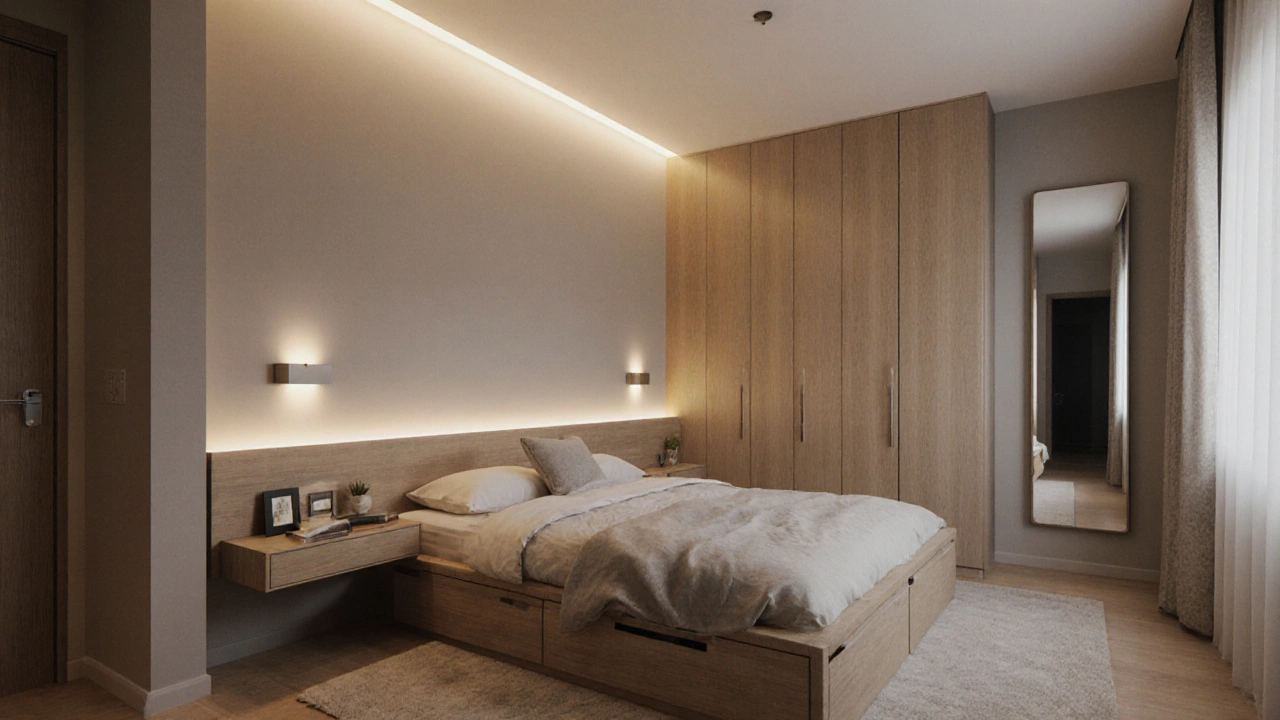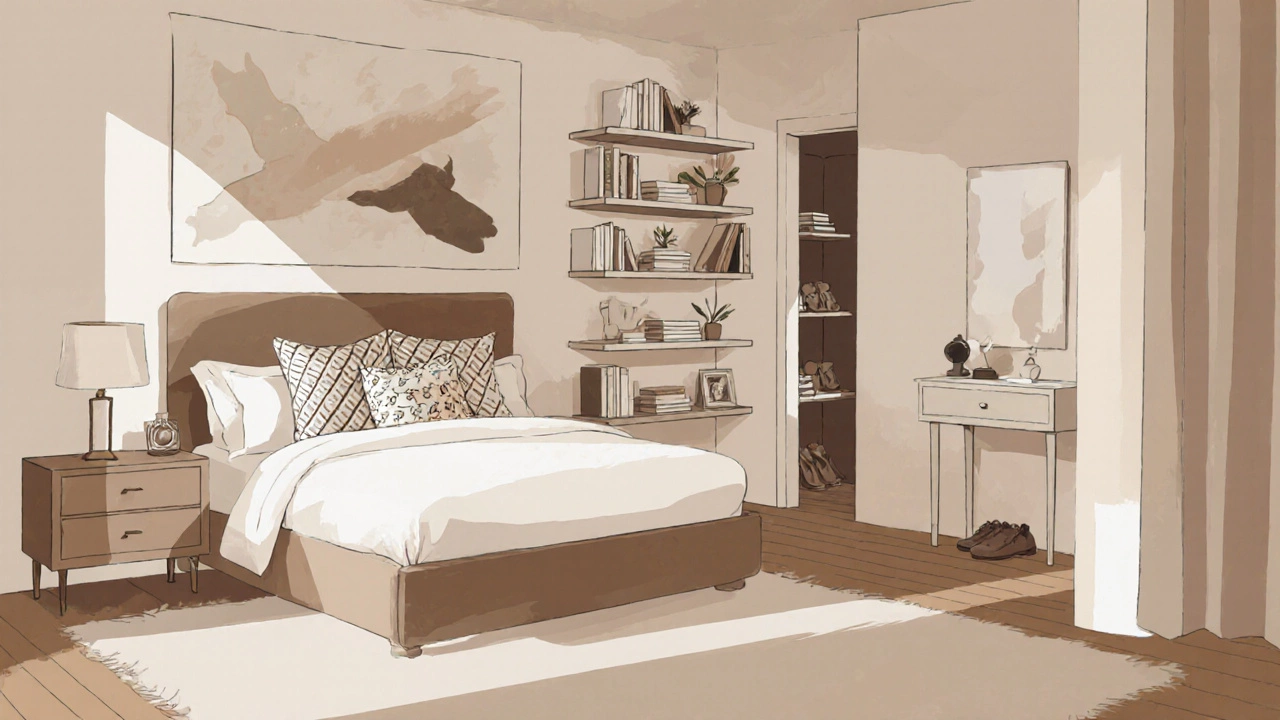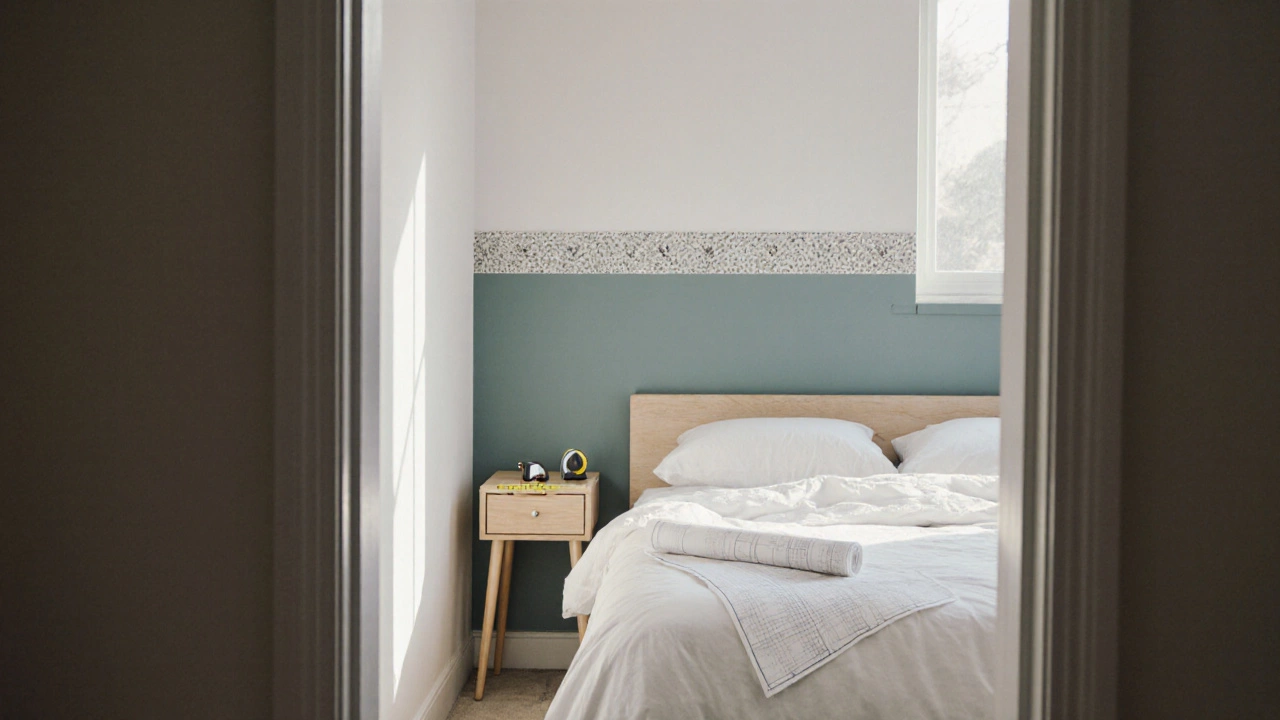Small Bedroom Space Calculator
Measure Your Room
Your Recommendations
Key Takeaways
- Start with accurate measurements and a clear floor plan.
- Light, neutral colors open up the room; add one bold accent if you want depth.
- Layer lighting (ambient, task, accent) to create a spacious feel.
- Choose scaled, multipurpose furniture and place it strategically.
- Integrate hidden storage, mirrors, and vertical décor to boost perception of size.
When a bedroom feels cramped, it’s easy to think you need a bigger space. The truth is, a few smart choices can transform even the tightest room into a stylish sanctuary. Below are the practical steps that turn a modest floor area into a place you actually want to spend time in.
Small bedroom design is all about balancing function and visual flow. First, get a precise measure of every wall, window, and door. Sketch a basic layout on graph paper or use a free mobile app - this gives you a sandbox to test furniture placement before you move anything.
1. Set the Foundation with a Light Color Palette
Color palette is the quickest way to enlarge a room visually. Paint the walls in soft whites, pale grays, or warm beiges. These hues reflect natural light, making the space feel airy. If you crave a splash of personality, paint just one wall in a muted teal or sage; the accent draws the eye without overwhelming the room.
Don’t forget ceilings - a ceiling painted the same shade as the walls adds vertical continuity, a trick that makes the room seem taller. For a subtle texture, consider a light‑reflecting wallpaper strip behind the headboard; it adds interest while keeping the overall tone light.
2. Master Lighting for Depth and Warmth
Lighting does more than brighten a room; it shapes perception. Combine three layers:
- Ambient: a ceiling fixture or recessed lights that spread soft diffusion across the ceiling.
- Task: bedside lamps or wall sconces for reading and dressing.
- Accent: LED strip lights behind a floating shelf or a small chandelier that adds visual height.
Choose bulbs with a color temperature of 2700‑3000K for a warm, inviting glow. Mirrors opposite a window bounce light further, amplifying the effect of every lamp.

3. Choose Scaled, Multi‑Purpose Furniture
Furniture should feel light and proportionate. Opt for a platform bed with a low profile - it frees up vertical space. If storage is needed, pick a bed with built‑in drawers or a headboard that includes hidden shelves.
A narrow nightstand with an open shelf works better than a bulky dresser. When you need a desk, consider a wall‑mounted fold‑down desk that tucks away after use. Keep legs visible; furniture with exposed legs creates an illusion of floor space, unlike solid, boxy pieces.
4. Maximize Storage without Bulking Up
Storage solutions are essential in any compact bedroom. Think vertically: tall, slim wardrobes or floor‑to‑ceiling shelves use height rather than width. Use the space under the bed for rolling bins or pull‑out drawers - great for off‑season clothes.
Floating shelves above the bedside keep night‑time essentials within reach while avoiding clutter on the floor. A narrow console table behind the door can double as a shoe rack and a decorative display.
Below is a quick comparison of popular storage options for small rooms:
| Option | Space Used | Cost | Best For |
|---|---|---|---|
| Built‑in wardrobe | Floor‑to‑ceiling | Medium‑high | Permanent storage, sleek look |
| Under‑bed drawers | Hidden under bed | Low | Seasonal clothes, accessories |
| Floating shelves | Vertical wall space | Low‑medium | Books, decor, night‑stand swap |
| Compact dresser | Floor area (narrow) | Medium | Everyday clothing, easy access |
5. Use Mirrors and Reflective Surfaces
Mirrors are the unsung heroes of tiny rooms. A large floor‑to‑ceiling mirror on one wall doubles the visual space instantly. If a full‑length mirror feels too bold, a tall, narrow mirror placed opposite a window sends natural light deeper into the room.
Glossy finishes on a bedside lamp or a lacquered nightstand also bounce light, adding a subtle sparkle that keeps the room from feeling flat.

6. Add Personality with Wall Art and Textiles
Wall art should be proportionate - a single statement piece or a series of small prints aligned horizontally works better than a crowded gallery wall. Choose frames with thin borders to keep the visual weight low.
Introduce texture through a rug, throw blankets, and cushions. A medium‑size rug (about 5x7ft) placed under the bed anchors the space without overwhelming it. Stick to the base color palette for the larger pieces, then sprinkle in a few bold accent colors through pillows or a patterned duvet.
7. Step‑by‑Step Layout Example
- Measure the room and draw a to‑scale floor plan.
- Pick a light wall color; paint all walls the same hue.
- Install a recessed ceiling light for even ambient illumination.
- Place the low‑profile platform bed against the longest wall, leaving at least 2ft of clearance on each side.
- Mount floating night‑stand shelves beside the bed; add a small table lamp on each.
- Add a tall wardrobe that reaches the ceiling on the opposite wall.
- Hang a floor‑to‑ceiling mirror on the wall adjacent to the wardrobe.
- Lay a neutral‑colored rug extending a foot beyond the bed’s edges.
- Finish with a single large artwork above the headboard and a few patterned cushions.
Follow these steps and you’ll see how every element works together to stretch the feeling of space.
8. Common Pitfalls and How to Avoid Them
- Over‑furnishing: Too many pieces crowd the floor. Stick to essentials.
- Heavy dark colors: Dark walls shrink a room. Reserve them for accents only.
- Ignoring vertical space: Tall shelves and vertical lines add perceived height.
- Neglecting lighting layers: A single overhead bulb leaves corners in shadow.
Frequently Asked Questions
Can I use a bold color in a tiny bedroom?
Yes, but limit it to one accent wall or a piece of furniture. The rest should stay light to keep the room open.
What’s the best bed size for a 10×10ft bedroom?
A queen‑size (60×80in) fits comfortably with clearance for nightstands. If the room is under 9×9ft, a full‑size bed is safer.
How do I hide wires and cables?
Use cord clips or a shallow raceway that runs along the baseboard. Paint the raceway the same color as the wall for a seamless look.
Should I install a ceiling fan in a small bedroom?
A slim, low‑profile fan with a light kit works well. It adds airflow without dominating the ceiling space.
Is it okay to have a rug that’s larger than the bed?
In a tiny room, keep the rug slightly smaller than the bed footprint. Too large a rug can make the floor feel cramped.
